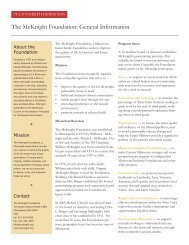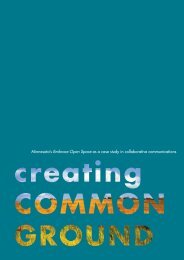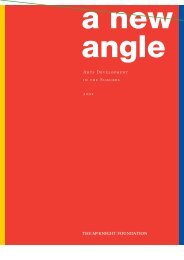Fallujah - McKnight Foundation
Fallujah - McKnight Foundation
Fallujah - McKnight Foundation
You also want an ePaper? Increase the reach of your titles
YUMPU automatically turns print PDFs into web optimized ePapers that Google loves.
Armajani had achieved international success by the end of the 1980s, with<br />
works included in the shows Documenta 8 and Skulptur Projekte Münster 87, a<br />
major survey exhibition at the Stedelijk Museum, the completion of the Irene Hixon<br />
Whitney Bridge in Minneapolis, and his collaboration with Scott Burton, Cesar Pelli,<br />
and M. Paul Friedberg on the celebrated World Financial Center Plaza in New york’s<br />
Battery Park City. He had put into exceptional practice the theoretical positions of his<br />
Manifesto: Public Sculpture in the Context of American Democracy, a call to replace<br />
artistic self-expression with functional works that serve a civic purpose. Armajani<br />
compiled this major statement between 1968 and 1978 and revised it in 1993.<br />
These achievements led to an unprecedented and ultimately life-changing<br />
commission to design a torch-and-bridge structure for the 1996 Summer Olympics in<br />
Atlanta, a project that put the work of a living artist in front of the nearly 40 million<br />
television viewers who watched Muhammad Ali light the cauldron, but in the end<br />
was so mismanaged that Armajani was forced to disown it. Although his design was<br />
praised by major critics outside Atlanta, it never became the city’s Eiffel Tower, which<br />
its steel latticework construction recalled. Perhaps it did not have the time to fully<br />
enter the consciousness of the city, in the way that often happens when bold new<br />
forms are first rejected and then later embraced by the public. The Atlanta Braves<br />
baseball team, which took over the stadium after the Olympics, disliked the structure<br />
so much that they moved it to the edge of a parking lot, where it remains today<br />
unused and abandoned, a sad symbol for what could have been a triumphal moment<br />
for contemporary art in America.<br />
Atlanta’s pivotal role in Armajani’s career may be viewed within the larger<br />
context of the privatization of public space, which has only grown since then, due in<br />
large part to governmental policies that increasingly place corporate interests over<br />
those of the common good. At the same time (and perhaps as a result), artists who<br />
take more activist and socially engaged positions have fewer opportunities to realize<br />
major public commissions than those whose interests and concerns reflect our more<br />
entertainment-driven reality. Armajani’s work has little in common with the current<br />
taste for public-art projects, which are by and large either mammoth pop spectacles<br />
or ephemeral interactions, usually presented in regularly programmed, privately<br />
owned spaces, and almost always temporary and fleeting.<br />
PG 25

















